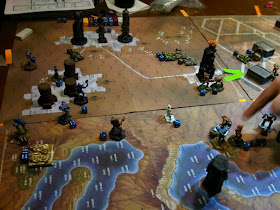I may have created some confusion in my previous posts on the information in dice (
1,
2). That's understandable, because the concept of information is complex and has
multiple interpretations, most of which I would not claim to really understand either. Let's see if I can sort this out without making an even bigger mess.
Shannon Information measures the information content of a random distribution of discrete events. A coin flip (heads/tail), a To-Hit roll (
hit/miss), and a Hit-Location roll (
arm, leg, torso, etc.) are all examples of this. What really matter here is not the number of dice rolled or coins flipped, but the number of possible outcomes and the probability of each. So you might use 4d6 to determine the result of a to-hit roll, but there are still only two outcomes -
hit or miss. In game terms, you can think this as the information you don't know
yet, just before you roll the dice, or the variability of outcomes of that roll.
Shannon information is measured on a logarithmic scale (
base 2), so each additional bit represents a doubling of information. In absolute terms, the difference between 10 and 11 bits of information is MUCH more than the difference between 2 and 3 bits. Be careful with this sort of comparison though, because it's a bit like comparing apples and oranges (
or comparing to-hit and hit location rolls). Such comparisons may not be meaningful.
There is an extension of Shannon Information to continuous outcomes, but this also requires changing the definition somewhat. I won't go too far into this, but there is one key point I'd like to make. When dealing with the sum of multiple dice, the distribution of the sum tend to become more like a
normal distribution as the number of dice increases. Calculating the entropy of the sum of 10D6 is a bit of work, but the entropy of a normal distribution is easy to calculate. Long story short, I can get a good guess at the entropy for the sum of a large number of dice by using the normal distribution as an approximation.
I had speculated about calculating the information in an entire game. This was rather silly of me, because this would mean framing the outcome of an entire game as a single probability distribution. I can't do that, but now I know how to make an educated guess. If I only considered the win/lose aspect of a game this would be easy, because that is just a complicated sort of discrete "coin-flip" outcome. The more interest way to look at this is to consider ALL the ways a game might play out, and to treat this as a sort of continuous outcome. The law of averages comes into play, some ways the game will play out are more likely than others. For instance, if at some point in the game you make multiple attacks to achieve an objective, perhaps to destroy an enemy tank, then in the final outcome of the battle it might not matter which attack was successful, so long as one of them was - they all lead to the same outcome. This might be stretching the concept too far, but I should be able to use the entropy of the normal distribution to approximate the amount of information of a very complicated random distribution - like that of an entire game.
Now I can make an educated guess about the information in a game. I'll use a Battletech example, but there is surprisingly little dependence on the game. The most common random event in Battletech is weapons fire, which includes the to-hit and hit-location rolls, which each have about about 3 bits each (
as calculated here). In a two player game where each player has 4 battlemechs, and each mech makes about 5 weapons attacks per turn, there will be about 10 random events per turn for the first 5 turns or so, about 200 random events, then a decreasing number of attack for the next 5 turns, call it 150 random events. That's 350 random events in one game, but I left out anything else that might require a die roll, so I'll round it up to 400. The basic random event in Battletech is about 3 bits, and 400 repeat random events adds about log
2(400) or 8.6 bits, for a total of 11.6 bits.
Sooooo ... now that I've gone through all that, it seems that the information in a game is just log
2 of the number of random events, plus a few bits of overhead. Does this mean anything all? I need to think on that.
Here is a partial answer: A game doesn't need any randomness at all, it could be completely strategic, like Chess. Add just a little bit of randomness, the whole game may depend on just a few rolls of the dice. As randomness increases the law of averages will come into play - Games like Risk and Battletech have many dice rolls - so many that the average effect of many rolls is almost always more important than single roll. Too much randomness, and players lose the ability to affect the outcome. The trick is getting is the right balance of randomness, and I don't think there is a formula for that.
PS: My friend
Ashely also recently noted that it might be a good idea to eliminate any rolling of the dice that doesn't significantly add to the game. Wisdom!
More:
Dice and Information
Dice and Information, So What?















